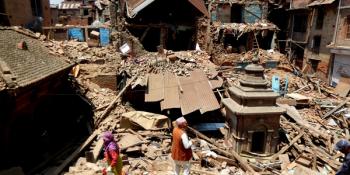
Geno Teofilo is Habitat for Humanity International’s Asia-Pacific disaster communications manager. He is in Nepal as part of an assessment team gathering updates following the devastating 7.8-magnitude earthquake on April 25, 2015. This is his account.
May 6, 2015
Together with some colleagues, I visited Habitat for Humanity’s Everest Build 1 site in Pokhara when I met Parvati Koirala. Surprising to me as an outsider, the 62-year-old grandmother was used to warding off monkeys that tried to steal from their gardens, or watching out for more serious threats from leopards and stray dogs. But the April 25 earthquake caught her totally by surprise.
“Everything was shaking back and forth!” she said waving her arms in a circular fashion to show the earthquake’s effect. “I yelled. I was afraid; my five-month-old grandson was in the house. I ran inside and grabbed the baby.”
According to Parvati, the earthquake continued, for what seemed like an eternity. “There was a drum fall of water, and the water was spilling out,” she said. ”I thought everything would be damaged. The house was shaking. I was afraid the house might fall over.”
After the tremors stopped, Parvati’s bamboo Habitat for Humanity house stood intact. “There was not so much damage,” she said. “There is only one big crack in the plaster in this house.”
I learned from Parvati that there were no casualties in the Begnas Taal community where she lives. I am thankful that Parvati and several Habitat home partners were safe, and that their bamboo houses survived without major damage. This is reassuring as Habitat looks to help earthquake-affected families in various ways such as rubble removal, shelter kit distribution, transitional shelter solutions and new home construction.
May 3, 2015
I almost can’t believe what I’m seeing.
To one side, I see a big two-story building destroyed by the earthquake. To the other side, there’s another big two-story building, also ruined. Right in between them is a house built by Habitat for Humanity. It’s still standing, and still in livable condition.
This sturdy little home is in a village called Paanchal, about an hour’s drive from Kathmandu. Habitat for Humanity volunteers and the home partner family had constructed this house during the Everest Build II in Kavre in 2012.
I’m learning that homes built by Habitat have far less earthquake damage than older neighborhood buildings made with less sturdy materials. The Habitat house looks solid, apart from a few small cracks in the walls and minor roof damage caused by bricks that fell from a building next door that collapsed.
Dalli Daniwar and her family used to live in a mud brick house a short distance from their Habitat home. Their former house is now a pile of rubble. Dalli and her family were fortunate to have moved into their Habitat home three years ago. Without it, the earthquake would have made them homeless.
May 2, 2015
Seeing a pile of rubble that used to be someone’s home is a jarring sight. But today we will start to fix that sad sight, and begin the process of recovery. Working with Nepali volunteers, Habitat for Humanity has begun to safely remove bricks and rubble left behind by the earthquake.
We went to a town called Opi Tol, about half an hour’s car ride from the capital Kathmandu. Habitat for Humanity Nepal’s staff handed out hard hats, gloves and surgical masks to the 80 volunteers, and everyone got to work. Volunteers from the Nepal Scouts, and people from the local community worked alongside Habitat staff, moving bricks and tiles by hand to clear a blocked roadway. The cleanup has begun.
I was even more heartened when a local resident walked up to me and told me that he wanted to help. Other residents joined the long human chains, handing bricks from one person to the next. When the bricks reached the end of the line, they were stacked up together, so that they could be recycled to rebuild neighborhood homes. This was a good first step, on Nepal’s long road to recovery.
“I’m very thankful for you coming here today,” said Dharma Govinda Maharjan, principal of a local secondary school. He is also the chairman of the town’s disaster committee. “As a human race, we should come together and help, as you did. We welcome you with open arms, and we’re happy that you came to help us at this moment.”
May 1, 2015
As our plane touches down in Kathmandu, we whiz past cargo planes from Thailand, and helicopters from India. Some of the choppers have their blades running, as they prepare to send emergency aid to outlying villages hit hard by the earthquake. These are among several foreign militaries that have brought much needed emergency aid and rescue teams to Nepal.
Yesterday, an 18-year-old Nepali was pulled from the rubble of a collapsed hotel by rescue workers. He had survived because a motorcycle next to him had stopped the collapsing ceiling from crushing him. Rescuers continue the desperate search for more trapped survivors.
This massive earthquake has also affected the Habitat for Humanity family. Two of our local staff members have been injured. Several have lost family members. A few have also lost their homes. Other Habitat Nepal staff, whose houses appear undamaged, are staying in tents at night. They are too fearful to sleep indoors, due to all the aftershocks.
Another earthquake occurred in the middle of last night. As I came to and the bedroom shook, I heard some neighbors screaming. In a few seconds, the quake stopped. So did the screaming. I’m fortunate to be staying in a strongly built house.
It will take time for people’s fear of earthquakes to subside. The process of recovery and building, however, must start now.